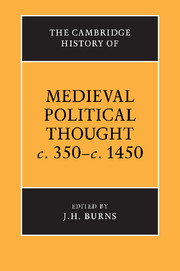Book contents
- Frontmatter
- Introduction
- I Foundations
- II Byzantium
- III Beginnings: c. 350–c. 750
- IV Formation: c. 750–c. 1150
- 8 Introduction: the formation of political thought in the west
- 9 Government, law and society
- 10 Kingship and empire
- 11 Church and papacy
- 12 The twelfth-century renaissance
- V Development: c. 1150–c. 1450
- Conclusion
- Biographies
- Bibliography
- Index of names of persons
- Index of subjects
- References
11 - Church and papacy
from IV - Formation: c. 750–c. 1150
Published online by Cambridge University Press: 28 March 2008
- Frontmatter
- Introduction
- I Foundations
- II Byzantium
- III Beginnings: c. 350–c. 750
- IV Formation: c. 750–c. 1150
- 8 Introduction: the formation of political thought in the west
- 9 Government, law and society
- 10 Kingship and empire
- 11 Church and papacy
- 12 The twelfth-century renaissance
- V Development: c. 1150–c. 1450
- Conclusion
- Biographies
- Bibliography
- Index of names of persons
- Index of subjects
- References
Summary
The Church and the ordo clericorum
Images of the Church
The period 750–1150 produced no treatise de ecclesia, nor did it witness ecclesiological speculation of the type familiar in the later Middle Ages. The intellectuals of these four centuries possessed not so much a ‘concept of the Church’ (Kirchenbegriff) as an ‘image of the Church’ (Kirchenbild) – or rather, multiple images, drawn from Holy Scripture. Trained, as most learned men of this period were, in the contemplative approach of the lectio divina, they knew that the whole Bible speaks of Christ and his Church ‘in spiritual similitudes … as through a glass darkly’. Reading the sacred page allegorice, the student would find as much ecclesiological as christological material. ‘The Church … is called by many names in Scripture, such as the kingdom of heaven, the woman, the bride, the wife, the dove, the beloved, the vine, the sheep, the sheepfold, the city, the tower, the pillar, the firmament, the house, the temple, the body of Christ, the net, the supper and others which the reader can perhaps find.’ The anonymous twelfth-century encyclopaedia of biblical typology, Allegoriae in universam sacram Scripturam, identifies eighty allegories of holy Church in the Old and New Testaments. Some of these allegoriae are more than metaphors: they are fully developed ecclesiological ideas of great power and complexity. In four of these allegories in particular – ‘the body of Christ’, ‘the ship’, ‘the bride’ and ‘the mother’ – the ecclesiology of the period 750–1150 can be traced. Corpus Christi.
- Type
- Chapter
- Information
- The Cambridge History of Medieval Political Thought c.350–c.1450 , pp. 252 - 305Publisher: Cambridge University PressPrint publication year: 1988
References
- 5
- Cited by

